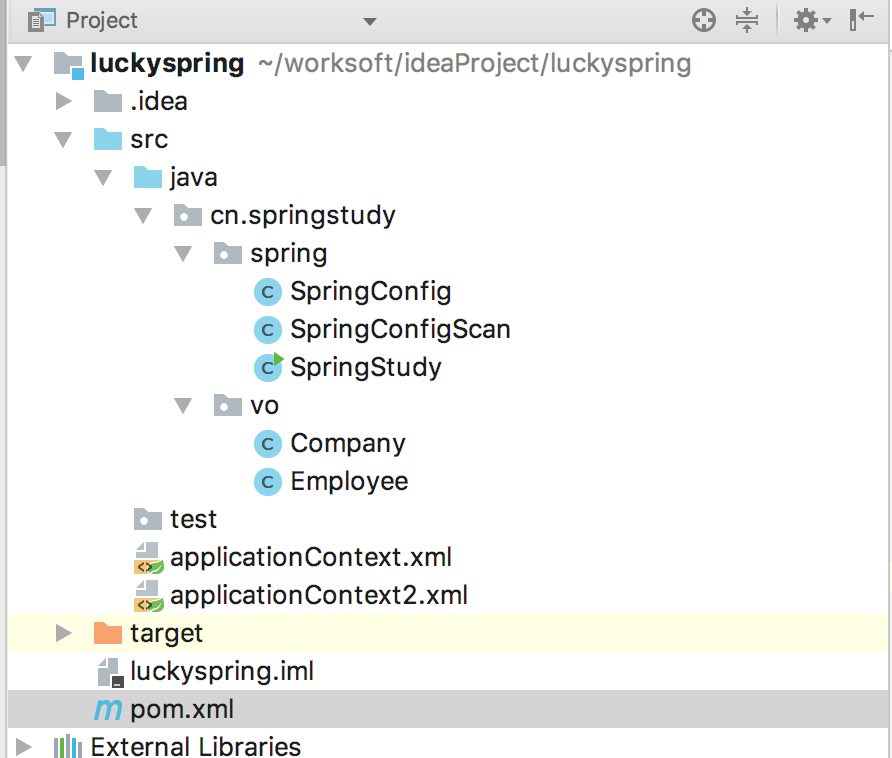Spring使用之IOC
这一段纯属废话,可以不用看........,兑现诺言,每周写一篇博客。最近除了学习算法,还有想更全面了解Spring框架的使用。于是开始了我的学习之旅。由于本人工作中接触的是一个非常非常老的项目,所以对Spring的了解仅仅停留在一些基本的使用上。为加深了解Spring提供的功能,于是就果断买了《Spring实战》,初略看下来,收获还是有的,但总感觉也不是特别特别优秀的书。接下来,我就来谈谈我对Spring的一点浅薄理解。
一、Spring第一印象
对于Java后端开发来说,Spring基本是再熟悉不过的框架了,甚至可以说,现在不用Spring框架进行开发的JAVA后端项目应该基本是凤毛麟角(个人猜测)。相信一提到Spring,大家想到的就是DI(Dependency Injection)/IOC(Inversion of Control)、AOP这些名词了,没错,这就是Spring提供的核心功能。DI、IOC说的就是同一个功能,翻译过来分别是依赖注入、控制反转,其实就是我们把对象的创建、销毁、维护交给Spring,让它帮我们管理这些对象,但我们需要的时候,让它直接给我们一个,不需要我们自己去new。AOP就是面向切面编程。额额,看着这些名词一脸懵逼.................................
接下来就来个小例子看看这到底能干嘛,能给我们编程提供什么样的帮助。。
在给小例子之前我们得先了解两个概念:
1、既然要让Spring帮我们创建管理对象、那我们就得先 告诉Spring怎么去创建这些对象,还有对象之间是什么关系。 Spring提供了3个方案来实现: 1、XML中显式配置。2、Java中显式配置。3、自动包扫描
2、Spring提供了俩种 容器 类型,分别为 BeanFactory、ApplicationContext 。BeanFactory只提供了基本的DI支持,ApplicationContext基于BeanFactory构建,能提供更多服务。
Spring上下文,就是一种容器,继承自ApplicationContext,提供更多功能,如常见的,
AnnotationConfigApplicationContext可从JAVA配置类中加载上下文
ClassPathXmlApplicationContext 从类路径下的XML文件中加载上下文。
FileSystemXmlApplilcationContext 从文件系统路径中加载上下文
例子
接下来我们用Idea编辑器,通过maven工具创建一个maven项目来体验下Spring。创建完之后我们首先要引入Spring jar包,通过maven,我们不需要自己去下载,只需要在配置文件中配置我们需要用到的jar包。项目结构如下图

之后我们在pom.xml文件中配置需要用到的jar文件,我们将spring的几个核心包配置进来。
<?xml version="1.0" encoding="UTF-8"?>
<project xmlns="http://maven.apache.org/POM/4.0.0" xmlns:xsi="http://www.w3.org/2001/XMLSchema-instance"
xsi:schemaLocation="http://maven.apache.org/POM/4.0.0 http://maven.apache.org/xsd/maven-4.0.0.xsd">
<modelVersion>4.0.0</modelVersion>
<groupId>cn.springstudy</groupId>
<artifactId>luckyspring</artifactId>
<version>1.0-SNAPSHOT</version>
<name>luckyspring</name>
<url>http://www.example.com</url>
<properties>
<project.build.sourceEncoding>UTF-8</project.build.sourceEncoding>
<maven.compiler.source>1.7</maven.compiler.source>
<maven.compiler.target>1.7</maven.compiler.target>
<!-- spring 版本 -->
<org.springframework.version>4.0.0.RELEASE</org.springframework.version>
</properties>
<dependencies>
<!-- 当前项目用到的3个核心spring jar包 -->
<dependency>
<groupId>org.springframework</groupId>
<artifactId>spring-context</artifactId>
<version>${org.springframework.version}</version>
</dependency>
<dependency>
<groupId>org.springframework</groupId>
<artifactId>spring-core</artifactId>
<version>${org.springframework.version}</version>
</dependency>
<dependency>
<groupId>org.springframework</groupId>
<artifactId>spring-beans</artifactId>
<version>${org.springframework.version}</version>
</dependency
<dependency>
<groupId>junit</groupId>
<artifactId>junit</artifactId>
<version>4.11</version>
<scope>test</scope>
</dependency>
</dependencies>
</project>
复制代码
现在假设我们有一个公司,一个公司里面得有雇员来工作,才能让公司提供服务,于是我们创建雇员类
package cn.springstudy.vo;
public class Employee {
public void work(){
System.out.println("Employ start to Work");
};
}复制代码
再创建公司类
package cn.springstudy.vo;
public class Company {
//公司类有个雇员对象
private Employee employee;
public void supportService(){
employee.work();
}
public Employee getEmployee() {
return employee;
}
public void setEmployee(Employee employee) {
this.employee = employee;
}
}复制代码
前面我们说过告诉Spring怎么去创建对象有三种方式
方式一XML配置来告诉spring怎么去创建我们的雇员还有公司类,在创建一个applicationContext.xml文件,内容如下
<?xml version="1.0" encoding="UTF-8"?>
<beans xmlns="http://www.springframework.org/schema/beans"
xmlns:xsi="http://www.w3.org/2001/XMLSchema-instance"
xsi:schemaLocation="http://www.springframework.org/schema/beans http://www.springframework.org/schema/beans/spring-beans.xsd">
<!-- 配置一个对象 指定该对象id为emplayee-->
<bean id="employee" class="cn.springstudy.vo.Employee"></bean>
<!--配置对象,之后往对象中放入一个Employee对象
ref="employee"表示注入的对象为spring容器中id为employee的对象,这样配置后创建Company
对象后,会自动调用setEmployee()方法放入一个Employee对象
-->
<bean id="company" class="cn.springstudy.vo.Company">
<property name="employee" ref="employee"></property>
</bean>
</beans>复制代码
接下来我们创建一个main函数作为程序的入口,在main函数中去创建Spring容器
package cn.springstudy.spring;
import cn.springstudy.vo.Company;
import org.springframework.context.annotation.AnnotationConfigApplicationContext;
import org.springframework.context.support.ClassPathXmlApplicationContext;
public class SpringStudy {
public static void main(String arg[]){
//方式一,XML文件中加载上下文,即Spring容器
ClassPathXmlApplicationContext classPathXmlApplicationContext = new ClassPathXmlApplicationContext("applicationContext.xml");
//从容器中获取一个Company对象
Company company = (Company) classPathXmlApplicationContext.getBean("company");
company.supportService();
}
}复制代码
执行一下,控制台打印如下

我们可以看到我们执行company.supportService()居然没报空指针,要知道我们可没在Company类中去创建Empoyee对象,说明什么???Spring容器自动帮我们创建Employee对象并set到Company对象中了。
方式二
创建一个配置Java类
package cn.springstudy.spring;
import cn.springstudy.vo.Company;
import cn.springstudy.vo.Employee;
import org.springframework.context.annotation.Bean;
import org.springframework.context.annotation.Configuration;
//注解,表明这个是一个Spring配置类
@Configuration
public class SpringConfig {
//Spring容器管理的类,通过Bean注解,方法名即默认为bean的id,也可在Bean注解后加参数指定Bean的ID
@Bean
public Employee employee(){
return new Employee();
}
//Spring容器管理的类,通过Bean注解
@Bean
public Company company(){
Company company = new Company();
company.setEmployee(employee());
return company;
}
}
复制代码
main函数,程序入口,执行结果同上
package cn.springstudy.spring;
import cn.springstudy.vo.Company;
import org.springframework.context.annotation.AnnotationConfigApplicationContext;
import org.springframework.context.support.ClassPathXmlApplicationContext;
public class SpringStudy {
public static void main(String arg[]){
//方式二,默认bean的名称即为配置方法的名称,需要用到AnnotationConfigApplicationContext容器
AnnotationConfigApplicationContext annotationConfigApplicationContext = new AnnotationConfigApplicationContext();
annotationConfigApplicationContext.register(SpringConfig.class);
annotationConfigApplicationContext.refresh();
Company company1 = (Company) annotationConfigApplicationContext.getBean("company");
company1.supportService();
}
}复制代码
方式三、
方式三序借助方式一或者方式二,我们首先需要在需要被Spring容器管理的类上面加上@Component注解,所以我们在Empoyee加上注解
package cn.springstudy.vo;
import org.springframework.stereotype.Component;
@Component
public class Employee {
public void work(){
System.out.println("Employ start to Work");
};
}复制代码
Company类上加上注解,需自动分配的对象上加@Autowired注解
package cn.springstudy.vo;
import org.springframework.beans.factory.annotation.Autowired;
import org.springframework.stereotype.Component;
@Component
public class Company {
//Autowired,帮我分配个Employee对象过来。
@Autowired
private Employee employee;
public void supportService(){
employee.work();
}
public Employee getEmployee() {
return employee;
}
public void setEmployee(Employee employee) {
this.employee = employee;
}
}复制代码
在配置类上加上包自动扫描路径
package cn.springstudy.spring;
import org.springframework.context.annotation.ComponentScan;
import org.springframework.context.annotation.Configuration;
//cn.springstudy.vo 为扫描的基础包路径
@Configuration
@ComponentScan("cn.springstudy.vo")
public class SpringConfigScan {
}复制代码
测试main方法
package cn.springstudy.spring;
import cn.springstudy.vo.Company;
import org.springframework.context.annotation.AnnotationConfigApplicationContext;
import org.springframework.context.support.ClassPathXmlApplicationContext;
public class SpringStudy {
public static void main(String arg[]){
//方式三,需借助方式2
AnnotationConfigApplicationContext annotationConfigApplicationContext2 = new AnnotationConfigApplicationContext();
annotationConfigApplicationContext2.register(SpringConfig.class);
annotationConfigApplicationContext2.refresh();
Company company2 = (Company) annotationConfigApplicationContext.getBean("company");
company2.supportService();
}
}复制代码
执行结果同上。
XML、Java配置文件混着使用
当然XML配置方式和Java配置文件还能混着用。
1、在 XML配置中混用Java配置 文件只需在配置文件中增加一个<bean></bea>即可将Java配置类导入XML配置中。2、 XML中导入其他XML配置 ,只需用<import>指定其他XML配置文件路径
<?xml version="1.0" encoding="UTF-8"?>
<beans xmlns="http://www.springframework.org/schema/beans"
xmlns:xsi="http://www.w3.org/2001/XMLSchema-instance"
xsi:schemaLocation="http://www.springframework.org/schema/beans http://www.springframework.org/schema/beans/spring-beans.xsd">
<!--导入其他XML配置文件 -->
<import resource="applicationContext2.xml"></import>
<!--Spring Java配置类-->
<bean class="cn.springstudy.spring.SpringConfig"></bean>
<bean id="employee" class="cn.springstudy.vo.Employee"></bean>
<bean id="company" class="cn.springstudy.vo.Company">
<property name="employee" ref="employee"></property>
</bean>
</beans>复制代码
1、Java配置文件混着XML配置文件 ,只需在Java类中加个注解即可,2、 Java配置类导入其他配置类 ,只需加@Import注解,指定配置类位置。
package cn.springstudy.spring;
import cn.springstudy.vo.Company;
import cn.springstudy.vo.Employee;
import org.springframework.context.annotation.Bean;
import org.springframework.context.annotation.Configuration;
import org.springframework.context.annotation.ImportResource;
@Configuration
//导入其他XML配置文件
@ImportResource("classpath:applicationContext.xml")
//导入其他配置类
@Import({SpringConfigScan.class})
public class SpringConfig {
@Bean
public Employee employee(){
return new Employee();
}
@Bean
public Company company(){
Company company = new Company();
company.setEmployee(employee());
return company;
}
}复制代码
Spring DI初步使用方法已经如上,接下来我们主要通过XML配置的方式来说明其他功能。
构造方法注入依赖对象
以上的小例子中Company中的Employee对象是通过setEmployee方法配置进去的。我们还可以通过构造方法的形式配置进去。
给Company类增加一个构造方法
package cn.springstudy.vo;
import org.springframework.beans.factory.annotation.Autowired;
import org.springframework.stereotype.Component;
public class Company {
private Employee employee;
private String name;
public Company(Employee employee,String name){
this.employee = employee;
this.name = name;
}
public void supportService(){
employee.work();
}
public Employee getEmployee() {
return employee;
}
public void setEmployee(Employee employee) {
this.employee = employee;
}
}复制代码
配置文件配置如下
<?xml version="1.0" encoding="UTF-8"?>
<beans xmlns="http://www.springframework.org/schema/beans"
xmlns:xsi="http://www.w3.org/2001/XMLSchema-instance"
xmlns:c="http://www.springframework.org/schema/c"
xsi:schemaLocation="http://www.springframework.org/schema/beans
http://www.springframework.org/schema/beans/spring-beans.xsd
http://www.springframework.org/schema/c
http://www.springframework.org/schema/c/spring-c.xsd">
<!--在上面beans中声明spring中c命名空间-->
<bean id="employee" class="cn.springstudy.vo.Employee"></bean>
<!-- 构造方法中注入Employee对象,还有一个名称其中
c:为命名空间前缀
emplayee、name分别为构造函数中参数的名称
-ref表示注入的是spring容器中的对象
"emplayee"表示引入的是id为emplayee的对象,name没有带-ref则是注入字符串juejin.com
-->
<bean id="company" class="cn.springstudy.vo.Company"
c:employee-ref="employee"
c:name="juejin.com">
</bean>
</beans>复制代码
工厂方法模式创建对象
以上说明Spring的依赖注入的基本使用。我们在编程时候可能不是通过new来创建对象,有时也会 使用静态方法(静态工厂模式)来创建对象 ,那么Spring是否支持呢?答案是肯定的。
public class ClientService {
private ClientService() {}
public static ClientService createInstance() {
return new ClientService()
}
}复制代码
<bean id="clientService"
class="examples.ClientService"
factory-method="createInstance"/>复制代码
当然工厂方法模式是通过非通过静态方法创建对象的,Spring也是支持的,如下
public class DefaultServiceLocator {
private static ClientService clientService = new ClientServiceImpl();
public ClientService createClientServiceInstance() {
return clientService;
}
}复制代码
<!-- 工厂类 -->
<bean id="serviceLocator" class="examples.DefaultServiceLocator">
</bean>
<!-- ClientService类配置 -->
<bean id="clientService"
factory-bean="serviceLocator"
factory-method="createClientServiceInstance"/>复制代码
Spring中bean的作用域
默认情况下,Spring容器中的bean都是单例的,可以通过配置修改。spring定义了多种作用域:
1、Singleton(默认) 单例
2、Prototype 原型,每次通过容器获取对象都会创建一个新对象、
3、Session 会话,一个web会话中使用一个对象
4、Request ,每次web请求使用一个对象
通过XML配置可在bean中指定scrop属性指定 ,
Java配置类可在方法上加注解@Scope("prototype")
自动扫描的类可在类上加注解@Scope("prototype")
<!-- scope 属性指定作用域 --> <bean id="employee" class="cn.springstudy.vo.Employee" scope="prototype"></bean>复制代码
@Component
@Scope("prototype")
public class Company {.....}复制代码
@Configuration
public class SpringConfig {
@Bean
@Scope("prototype")
public Employee employee(){
return new Employee();
}
}复制代码
最后,感觉这篇写得有点乱,也很基础,还有很多东西没说到,不知道看到这里的人儿有无收获,说好的一周一篇,额,那就先发出来吧,以后可能还做修改,待续。。
- 本文标签: 测试 配置 XML client bean 构造方法 翻译 cat App build Service 静态方法 web tar CTO example Property session apache 空间 schema 下载 id java https 代码 Java类 博客 文件系统 spring pom 管理 开发 http AOP maven IDE dependencies core IO classpath UI 参数 src ioc junit
- 版权声明: 本文为互联网转载文章,出处已在文章中说明(部分除外)。如果侵权,请联系本站长删除,谢谢。
- 本文海报: 生成海报一 生成海报二











![[HBLOG]公众号](https://www.liuhaihua.cn/img/qrcode_gzh.jpg)

